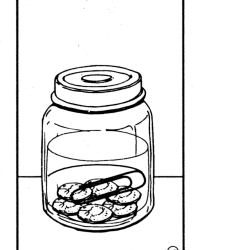Source Institutions
Source Institutions
Add to list Go to activity

Learners design their own experiment to investigate how pollution diffuses through ground material. This model for leaking underground storage tanks helps learners connect their learning to ecological environments. Includes extensions on page 11. The first extension frames an experiment using observations from the activity, and the learners are also challenged to create a better tank. Part of the 21-activity guide published by OMSI, No Hassle Messy Science with a Wow. All activities in this guide use household materials and all lesson plans include preparation directions, demonstrations, procedure sheets, cross-curricular connections, and scientific explanation of content.
- 10 to 30 minutes
- 30 to 45 minutes
- $1 - $5 per group of students
- Ages 11 - 14
- Activity, Experiment/Lab Activity, Lesson/Lesson Plan
- English, Spanish
Quick Guide
Materials List (per group of students)
- flat plastic lids, 4–6 inches in diameter, 4 per group (from oatmeal tubs, yogurt containers, peanut butter jars, mayonnaise jars, and butter tubs)
- water 1–2 cups per group
- plastic squeeze bottles,12 oz or larger 1 prgrp
- M&M’s™ 1 pound per class
- flour (corn starch also works) ½ cup per group
- rice ½ cup per group
- sand ½ cup per group
- plastic cups, 8 oz. 3 per group
- plastic spoons or teaspoons 2 per group
- measuring cups, beakers, several to share
- Diffusion Measuring Tools (p. D-46) 1 page per class
- transparency sheets (optional) 1 per group
- ruler (optional) 1 per group
- watch or view of the classroom clock
Subjects
-
Engineering and Technology
-
Engineering
- Environmental Engineering
-
Engineering
-
Life Sciences
-
Ecology
- Ecosystems
- Human Impact
-
Ecology
-
Mathematics
- Measurement
-
Physical Sciences
-
Chemistry
- Solutions
-
Chemistry
-
The Nature of Science
-
Science and Society
- Risks and Benefits
-
The Scientific Process
- Conducting Investigations
- Gathering Data
- Formulating Explanations
- Communicating Results
-
Science and Society
-
The Nature of Technology
-
The Design Process
- Invention and Innovation
-
The Design Process
Informal Categories
- Nature and Environment
Audience
To use this activity, learners need to:
- see
- see color
- read
- touch
Learning styles supported:
- Involves teamwork and communication skills
- Uses STEM to solve real-world problems
- Involves hands-on or lab activities
Other
Foreign language versions of this resource:
Components that are part of this resource:
Includes alignment to state and/or national standards:
Access Rights:
- Free access
By:
- Oregon Museum of Science and Industry
Rights:
- All rights reserved, Oregon Museum of Science and Industry, 2007
Funding Sources:
- National Science Foundation
- Camille and Henry Dreyfus Foundation
